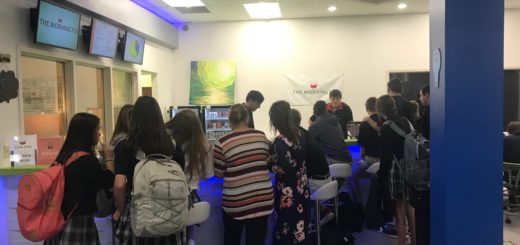My COVA Journey as a Learner
I’m going to spend the next few weeks reflecting upon my learning journey over the last 18 months in several posts here on the blog. This first post really surrounds what I have come to embrace as Choice, Ownership, Voice through Authentic assessments (I prefer learning to assessments) or COVA. I always want to explore how I continue to try to create significant learning environments that capitalize on this COVA approach. The following two videos can serve as a primer for any of you not familiar with these pedagogies.
While I never called it COVA, I had made the transition to a more self-directed learning approach in my teaching prior to this learning journey I started 18 months ago. I had gone back into the classroom a few years prior to co-teach an Economics class using the flipped model. This allowed us to change the dynamics of class time to be much more student directed. We also had each student contribute to a blog once a week where they applied economic principles to subjects they were passionate about. This allowed us to see students applying concepts like inflation to the fashion world and truly let them have some ownership and a voice in the learning. Then the semester prior to starting the program I taught a blended version of Economics where students attended face-to-face class 2 or 3 times a week and worked online the other days. We continued the blogs and moved a step further by having students bring in audio and video examples of the concepts we were learning and lead the class discussions. You can see several examples of what I learned in each of these classes on my presentations and publications page. All of this is to say I was wholly bought into the concept of COVA without calling it that but I hadn’t really approached it from the learner’s perspective.
With all this knowledge and experience trying out these pedagogies you would think transitioning into the learner’s role in such an environment would be easy. While it was at first, I experienced a backslide a couple months into my journey. I call the last 18 months a learning journey because that truly is what is had been. While I have been in a formal program, Digital Leading and Learning at Lamar University, the program is designed to empower your learning through COVA and creating a significant learning environment. At first we started building out the environment in which we would live for the next 18 months which is where this space sprang from. Like my students, I was allowed to create my own reflective space to share my journey. I experienced my backslide into old thinking a few months in however. The next step in our journey involved creating an innovation plan, the significant learning environment we would actually try to create for our own students over the following year. We were given parameters and guidelines similar to what I would give my students but then we were to use our choice, ownership and voice to share our learning path. This is where I encountered what I am sure my students had felt previously. I started venturing down a path only to be told by my mentor that it wasn’t a significant enough path. See as teachers and learners we still struggle with mixing COVA with the learning goals of whatever environment we are in.
After the initial pushback to my first innovation plan, I was frustrated. I’m sure many of my students had felt this same frustration in a class I had led before as well so looking back now I want to unpack my feelings. I was told my idea on personal growth plans for faculty wasn’t significant enough a project to fulfill the requirements of the year-long journey and I should look at something else. Looking back now I see a flaw in the lack of understanding of the complete path I was about to take. It makes me consider how we as teachers need to make sure we create constraints around our learning goals that are clear but not rigid. For example when we had our Fabrication class make land sailors to become proficient in different equipment, we gave them the following clear constraints.
- It has to roll via wind power
- It could not be larger than a foot long or wide and not more than two feet tall
- It had to utilize something fabricated from the laser cutter, 3D printer and vinyl cutter
That was it. What they did beyond that was up to them. We had defined a problem for them and given them constraints but how they solved it was up to their choice, ownership and voice which would then result in authentic learning. The only adjustments I would have made include smaller groups of 2 instead of 3 or 4 and actually testing of parts more often along the way.
So back to my initial innovation project idea….I never fully understood what constraint I was not completing in my proposal – so looking back I would have fought for it more; however, I fell back into my old school mindset and changed it to something more readily accepted by my mentor. What I realize now is that he was just trying to get me to think more deeply. As I altered my plan to the entrepreneurial track I have investigated the last year, I came to embrace the feedback more readily. I also learned to come better prepared with supporting information when I was looking for feedback so I could defend my choices. I think this is the biggest take away for me in the COVA approach as both a learner and a leader. We need to push each other to dig deeper and ensure we are reaching our learning goals without defining the path too rigidly. I love this graphic of the swimming pool of inquiry. How do we as learners and leaders navigate from the shallow end to the deep end in a meaningful but not prescriptive manner. When I learned that I was in control of how I shared my learning and could embrace the guiding of my mentors I really took off on my journey.
There were other times throughout the program where I had to reaffirm my thinking surrounding COVA. These times really had me reflect on was I simply not digging deeply enough into my own thinking our did I not clearly understand the learning objectives. Each of these will help me to be a better leader of a classroom and of professional development. COVA really allows you to think deeply about how we create these significant learning environments. This experience as a COVA learner has also made me ask for feedback when I am the leader in the room. Am I giving enough room for their voice while still being true to the constraints that will lead to my learning goals.
My final understanding of COVA came recently when I was put into an environment that was more traditional. I quickly appreciated how much I have enjoyed my DLL journey and the ownership I had in making it relevant to my learning environment. Having assessments that were much more prescriptive and defined reduced the quality of my work significantly. While the information I learned was valuable I know my retention of it is not nearly as permanent. I fell back into my old “checking the boxes” way of doing school. If you look at my transcript it will objectively assess that I learned as much as in other classes but I know this is far from the truth. I see this many times in the classroom as well. When mentors ask open ended questions their learners go well beyond the traditional expectations. I could give endless examples from leading classes but I think the best example exists right here. In the traditional model the teacher would have told me to write a 500 word reflection and guess what I bet this would have been around 500 words. With COVA I was simply told to write a reflection by my mentor and this is now three times as long.
This brings me to my final point. How do you know you have created a significant learning environment utilizing COVA? I think a great way is to listen to the words people use. Is it “we” or “I”? Is it “feedback” or a “grade”? Is it “teacher” or “mentor”? I would like to thank my mentors for helping me gain a better understanding that will hopefully empower me to continue to create better learning environments where we can all learn together.

